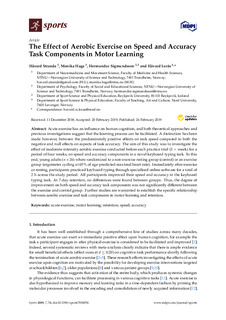| dc.contributor.author | Stranda, Håvard | |
| dc.contributor.author | Haga, Monika | |
| dc.contributor.author | Sigmundsson, Hermundur | |
| dc.contributor.author | Lorås, Håvard Wuttudal | |
| dc.date.accessioned | 2019-09-24T06:14:02Z | |
| dc.date.available | 2019-09-24T06:14:02Z | |
| dc.date.created | 2019-03-04T10:30:15Z | |
| dc.date.issued | 2019 | |
| dc.identifier.issn | 2075-4663 | |
| dc.identifier.uri | http://hdl.handle.net/11250/2618321 | |
| dc.description.abstract | Acute exercise has an influence on human cognition, and both theoretical approaches and previous investigations suggest that the learning process can be facilitated. A distinction has been made however, between the predominately positive effects on task speed compared to both the negative and null effects on aspects of task accuracy. The aim of this study was to investigate the effect of moderate-intensity aerobic exercise conducted before each practice trial (3 × week) for a period of four weeks, on speed and accuracy components in a novel keyboard typing task. To this end, young adults (n = 26) where randomized to a non-exercise resting group (control) or an exercise group (ergometer cycling at 65% of age-predicted maximal heart rate). Immediately after exercise or resting, participants practiced keyboard typing through specialized online software for a total of 2 h across the study period. All participants improved their speed and accuracy in the keyboard typing task. At 7-day retention, no differences were found between groups. Thus, the degree of improvement on both speed and accuracy task components was not significantly different between the exercise and control group. Further studies are warranted to establish the specific relationship between aerobic exercise and task components in motor learning and retention. | nb_NO |
| dc.language.iso | eng | nb_NO |
| dc.publisher | MDPI | nb_NO |
| dc.rights | Navngivelse 4.0 Internasjonal | * |
| dc.rights.uri | http://creativecommons.org/licenses/by/4.0/deed.no | * |
| dc.title | The Effect of Aerobic Exercise on Speed and Accuracy Task Components in Motor Learning | nb_NO |
| dc.type | Journal article | nb_NO |
| dc.type | Peer reviewed | nb_NO |
| dc.description.version | publishedVersion | nb_NO |
| dc.source.volume | 7 | nb_NO |
| dc.source.journal | Sports | nb_NO |
| dc.source.issue | 3 | nb_NO |
| dc.identifier.doi | 10.3390/sports7030054 | |
| dc.identifier.cristin | 1682035 | |
| dc.description.localcode | © 2019 by the authors. Licensee MDPI, Basel, Switzerland. This article is an open access article distributed under the terms and conditions of the Creative Commons Attribution (CC BY) license (http://creativecommons.org/licenses/by/4.0/). | nb_NO |
| cristin.unitcode | 194,65,30,0 | |
| cristin.unitcode | 194,67,40,0 | |
| cristin.unitname | Institutt for nevromedisin og bevegelsesvitenskap | |
| cristin.unitname | Institutt for psykologi | |
| cristin.ispublished | true | |
| cristin.fulltext | original | |
| cristin.qualitycode | 1 | |

